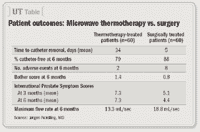Article
TUMT is found safe, effective alternative to surgery
San Antonio--Minimally invasive transurethral microwave thermotherapy using the ProstaLund Feedback Treatment (PLFT; ProstaLund, Lund, Sweden) system is a safe and effective alternative to surgery in patients with symptomatic BPH and persistent urinary retention, regardless of prostate size, according to Scandinavian investigators. Their conclusion is based on a prospective, randomized, multicenter comparison study of the two approaches presented at the AUA annual meeting here.

Urologists from 17 clinics in Denmark, Norway, and Sweden participated in an open trial with 120 patients randomized 1:1 to undergo PLFT or surgery with transurethral resection of the prostate or open prostate enucleation. Eligible patients were at least 45 years old, had a prostate volume of at least 30 mL, and had failed at least two attempts at catheter removal performed at least 1 month apart.
Mean time to catheter removal was 34 days in the PLFT group and 5 days in the surgery group. After 6 months, 79% of men who underwent a single PLFT treatment were catheter-free, compared with 88% of men who underwent surgery.

"Minimally invasive microwave thermotherapy with the ProstaLund device has been shown in retrospective studies to be effective for treating men with BPH in chronic urinary retention," he said. "To our knowledge, however, this is the first prospective controlled study with a surgical control group. The results are consistent with the retrospective data and indicate that PLFT offers a needed alternative to allow men who may be unfit for surgery to avoid lifelong treatment with an indwelling catheter.
"This is also the first prospective clinical study evaluating PLFT in men with a prostate volume greater than 100 mL. Interestingly, the outcomes for those patients with respect to bother score, IPSS, and Qmax are almost identical to those reported in an earlier multicenter study of PLFT that enrolled only men with prostates between 30 and 100 mL."
Bother score in both groups was 4.6 at baseline. At 6 months after surgery, mean bother score was 1.4 in the PLFT group and 0.8 in men who had undergone surgery.
The IPSS in the PLFT group was 7.3 at 3 months, and remained at that level at 6 months. Mean IPSS in the surgery group was 5.1 at 3 months and improved to 4.4 at 6 months. Maximum flow rate at 6 months was 13.3 mL/sec in the PLFT group and 18.8 mL/sec after surgery. Investigators plan to continue follow-up to 3 years.
Newsletter
Stay current with the latest urology news and practice-changing insights — sign up now for the essential updates every urologist needs.
















